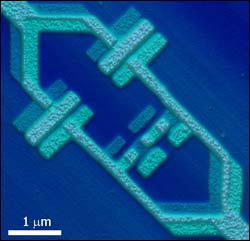This area deals with the fundamental laws and building blocks of nature and how they interact, the properties and the behavior of matter, and research into space and time and their structures.
innovations-report provides in-depth reports and articles on subjects such as astrophysics, laser technologies, nuclear, quantum, particle and solid-state physics, nanotechnologies, planetary research and findings (Mars, Venus) and developments related to the Hubble Telescope.

As of 6 July 2005, 990 comets have been discovered using the ESA/NASA Solar and Heliospheric Observatory (SOHO) spacecraft, which is expected to discover its 1000th comet this summer.
The SOHO spacecraft, a joint effort between NASA and the European Space Agency, has been so prolific that it has accounted for almost half of all comet discoveries for which orbits have been computed in the history of astronomy.
Before SOHO was launched, only 16 ‘sungrazing’ comets had be

Quantum computers that store information in so-called quantum bits (or qubits) will be confronted with a fundamental limitation. This is the claim made by Dutch theoretical physicists from the Foundation for Fundamental Research on Matter (FOM) and Leiden University in an article recently published in the journal Physical Review Letters.
A quantum computer can only function if the information exists for long enough to be processed. The so-called coherence of the qubit ensures that the qu

Dutch researcher Bram Wijngaarden investigated how bottom quarks are created during collisions between protons and antiprotons. Wijngaarden’s measurements have contributed to a better understanding of the theory, and can be used to explain why the production of these quarks during such collisions is higher than had originally been expected.
Bram Wijngaarden investigated the creation of bottom quarks using the D zero experiment of the particle accelerator at the Fermi lab in

ESA’s XMM-Newton observations of Comet 9P/Tempel 1 revealed that the object is a weak X-ray source. These data were acquired on 4 July 2005 by one of the EPIC X-ray cameras on board the spacecraft during the post-impact observation phase.
XMM-Newton observed that Tempel 1 emits X-rays, as suspected from previous observations of comets, but this emission is very weak. It is not certain whether it is possible to obtain spectral data which indicate the mechanisms by which the c

Scientists using the Swift satellite witnessed a tale of fire and ice today, as NASA’s Deep Impact probe slammed into the frozen comet Tempel 1. The collision briefly lit the dim comet’s surface and exposed, for the first time, a section of ancient and virgin material from the comet’s interior.
Swift is providing the only simultaneous multi-wavelength observation of this rare event, with a suite of instruments capable of detecting optical light, ultraviolet, X-ray

A new research article outlines another aspect of Quantum Cryptography
In “No Signaling and quantum key distribution”, a new paper published in Physical Review Letters 95 (010503 – 2005), Barrett, Hardy and Kent give the first example of a way of implementing quantum cryptography which is provably secure – even if quantum theory is incorrect, so long as a successor theory shares with quantum theory the features which make faster-than-light signaling impossible. The scheme can b